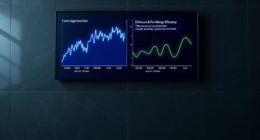A volatile investment involves significant price swings over a short period, which can present both opportunities and risks. For instance, a tech stock might experience sharp fluctuations following earnings reports, making it appealing to risk-tolerant investors. Typically, these investments have a beta greater than 1, indicating a tendency to move more than the market. While high volatility can lead to substantial profits, it can also result in significant losses. Understanding market dynamics and maintaining emotional control is vital for navigating these risks. To explore strategies for managing volatility, you might want to consider what comes next.
Key Takeaways
- A volatile investment experiences significant price fluctuations, often resulting from market conditions or investor sentiment.
- Higher volatility typically indicates larger price swings, which can present both risks and opportunities for investors.
- Investments with a beta greater than 1 are considered high volatility, attracting risk-tolerant investors seeking profit potential.
- The Cboe Volatility Index (VIX) serves as a benchmark for assessing overall market volatility and investor fear.
- Effective trading strategies in volatile markets include day trading and long straddles, which capitalize on rapid price movements.
Volatility in Financial Markets

When you look at financial markets, it's clear that volatility plays a crucial role in shaping investment decisions. Volatility refers to the degree of variation in trading prices, indicating the associated risk. Higher volatility often signals larger price swings in stocks, presenting both opportunities and challenges for traders.
The Cboe Volatility Index (VIX), known as the "Fear Gauge," reflects market expectations of near-term volatility through S&P 500 options prices. Understanding historical volatility helps you gauge past price fluctuations, while implied volatility informs you about future expectations based on option pricing.
Effective risk management is essential when navigating volatile investments, as strategies like long straddles and swing trading can yield rewards but also expose you to significant losses.
Understanding Investment Price Swings

Volatility in financial markets often leads to significant price swings in investments, which can create both opportunities and challenges for you as an investor.
Understanding historical volatility helps you gauge past price movements, typically over 10 to 180 trading days. High volatility investments, often with a beta greater than 1, tend to move more dramatically than the market index, appealing to risk-tolerant investors seeking higher returns.
The Cboe VIX Index, known as the Fear Gauge, measures stock market volatility and reflects investor sentiment about future price fluctuations.
Price Movement Dynamics Explained

Understanding price movement dynamics is crucial for navigating the complexities of volatile investments. When volatility is high, you'll notice significant price fluctuations that can lead to both risks and opportunities.
Historical volatility helps quantify past price movements, offering insights into potential future risks. On the other hand, implied volatility, derived from options pricing, reflects market expectations of future volatility.
The Cboe VIX Index acts as a barometer for market volatility, often referred to as the Fear Gauge. By grasping these dynamics, you can develop effective trading strategies.
High volatility can enable you to profit from rapid price movements through tactics like long straddles or day trading, making it essential to stay informed and agile in your approach.
Pros and Cons of Volatility

Navigating the landscape of volatile investments comes with both perks and pitfalls. On the upside, market volatility offers opportunities for high returns, especially for day traders and swing traders who thrive on price swings. Utilizing strategies like long straddles can help you capitalize on significant market movements in either direction.
However, the cons are equally compelling; the same volatility that fuels potential profits can also lead to substantial losses. Emotional responses to market swings often result in poor decision-making, particularly for long-term investors who may see volatility as an obstacle.
Understanding these pros and cons is crucial for effectively managing your approach to volatile investments and aligning your strategy with your risk tolerance.
Volatility vs. Stability

While many investors chase the allure of high returns, it's crucial to weigh the differences between volatile and stable investments.
Volatile investments often showcase significant price movements, reflected by high beta values and historical volatility, indicating greater risk. In contrast, stability is characterized by low volatility, where assets have beta values close to 1 or below, suggesting less erratic price behavior.
During uncertain market environments, the Cboe VIX Index becomes a key indicator, with higher values signaling increased investor fear.
While you might see volatile investments as opportunities for substantial gains, remember that they come with heightened risk. Understanding these dynamics can help you navigate the balance between potential rewards and the stability you seek in your portfolio.
Market Timing Difficulties

Investing in volatile markets presents unique challenges, especially when it comes to timing your trades. The rapid price movements can make it tough to predict when to buy or sell.
When stock prices move quickly, day traders and options investors often find themselves relying on emotions, leading to impulsive decisions that derail their strategies. High volatility can also distort your time frame, complicating market timing efforts. You might miss out on crucial trading days, which historical data shows can significantly reduce your overall returns.
Additionally, the fear index reflects increased uncertainty, making it even harder to gauge optimal entry and exit points. Ultimately, the volatility that occurs in these markets demands a careful approach to avoid costly missteps.
Emerging Market Volatility Patterns

Emerging markets often display distinct volatility patterns that can catch investors off guard, especially when political instability or economic shifts arise.
These markets often experience sharper price swings than developed ones, with volatility rates exceeding 20% annually. Factors like changes in commodity prices can rapidly influence capital inflows and outflows, amplifying this volatility.
Investor sentiment plays a crucial role, as geopolitical tensions or trade disputes can trigger abrupt price movements.
You'll notice that the VIX Index, which gauges market fear, often correlates with emerging market indices, indicating that heightened global risk perception exacerbates volatility.
Understanding these dynamics is vital for navigating the unpredictable nature of emerging markets and managing your investment strategies effectively.
Diversify to Mitigate Risks

To effectively manage risks associated with volatile investments, diversifying your portfolio is essential. By incorporating various asset classes, you can significantly reduce the overall risk and minimize the negative impact of any single investment's poor performance.
A well-diversified portfolio can enhance your risk-adjusted returns and reduce volatility by up to 30% compared to a more concentrated investment strategy. Aim for a mix of equities, fixed income, and alternative investments to withstand market fluctuations.
Focus on assets with low or negative correlations; when one performs poorly, others may excel, stabilizing your returns. Always align your diversification strategy with your risk tolerance and financial goals to ensure that volatile investments won't jeopardize your long-term success. Additionally, consider utilizing employer-sponsored retirement accounts as part of your investment strategy to further enhance financial stability.
Frequently Asked Questions
What Is the Meaning of Volatile Investment?
When you hear the term "volatile investment," it refers to assets that experience significant price changes over short periods.
This volatility often means higher risks and the potential for both large gains and losses.
You might notice that certain sectors, like technology or commodities, tend to be more volatile due to market sentiment and economic factors.
Understanding this concept helps you navigate investment decisions and strategies effectively, especially if you're considering trading options or day trading.
What Is an Example of Volatility?
An example of volatility is when you notice a stock's price jumping around wildly in a short period.
For instance, imagine you buy shares of a tech company and, within just a few days, the price soars by 30% due to a positive earnings report.
Then, just as quickly, it drops 20% because of bad news.
This kind of rapid price change is what makes investing in certain assets quite exciting and risky.
Are Volatile Stocks Good?
Are volatile stocks good? It depends on your risk tolerance and investment strategy.
If you're a short-term trader, you might find opportunities to profit from their price swings. However, be cautious; these stocks can lead to significant losses just as easily.
If you can handle the ups and downs and employ solid risk management, they could work for you.
Otherwise, you might want to consider more stable options for your portfolio.
What Are the Four Types of Volatility?
You'll encounter four main types of volatility: historical volatility, which looks at past price swings; implied volatility, reflecting market expectations for future fluctuations based on option prices; realized volatility, measuring actual price movements over a period; and forecasted volatility, predicting future changes using statistical models.
Each type offers insights into market behavior and can help you make smarter investment decisions, so it's essential to understand how they differ.
Conclusion
In summary, knowing about volatile investments helps you navigate the ups and downs of the market. While they can offer great opportunities for high returns, they also come with risks that can impact your portfolio. By understanding price movements and diversifying your investments, you can better manage those risks. So, keep an eye on market trends and don't shy away from volatility; instead, use it to your advantage for a balanced investment strategy.









